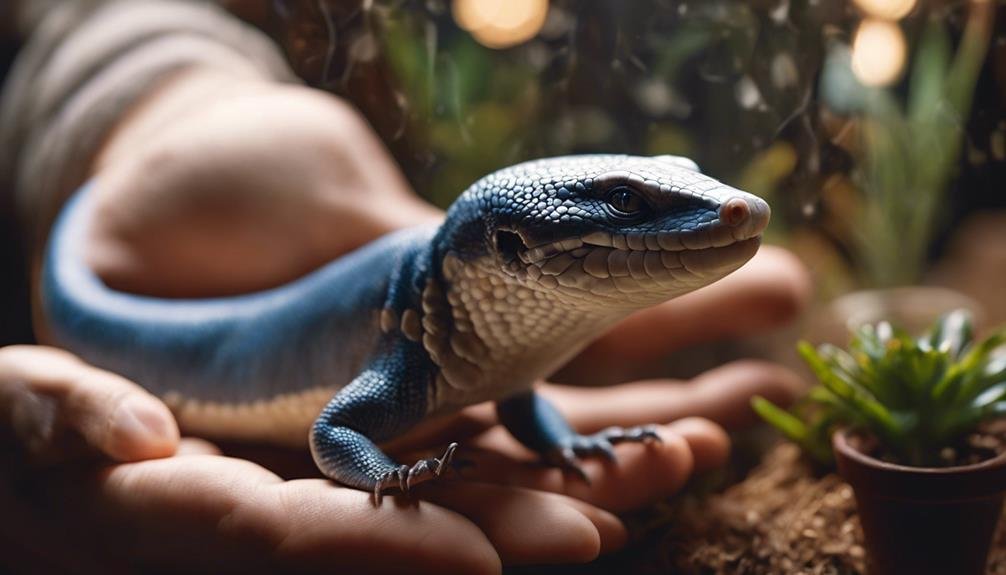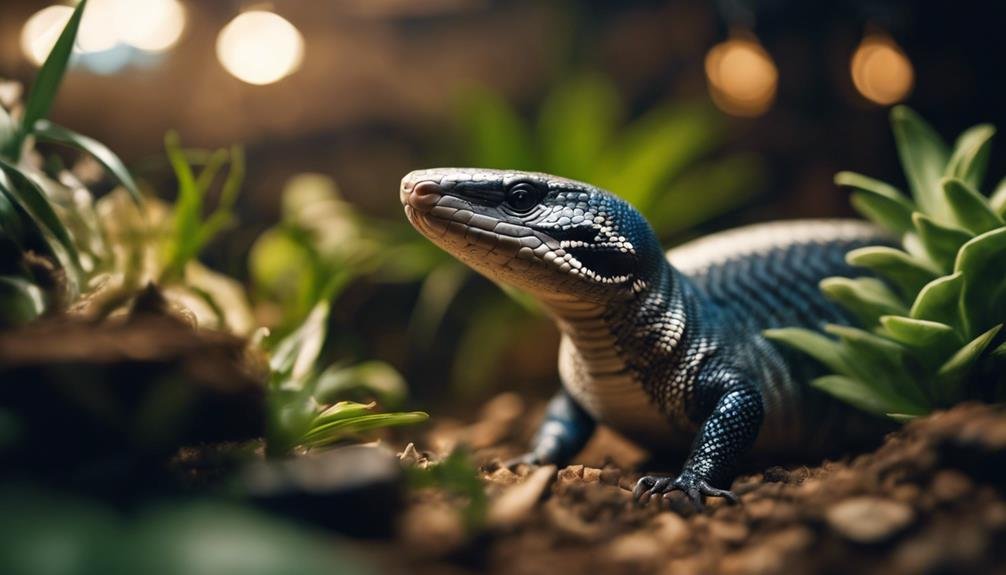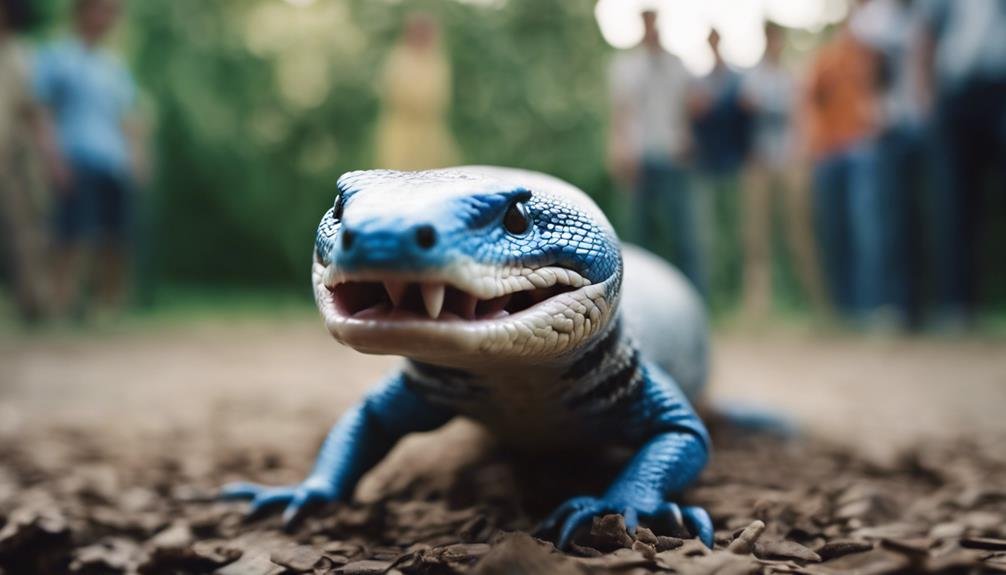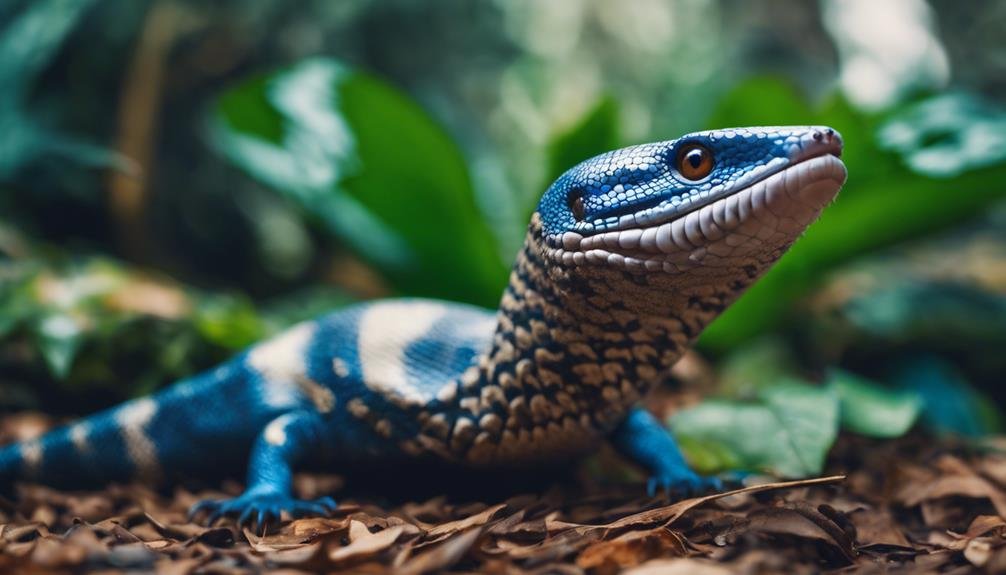You've likely come across Blue Tongue Skinks, with their distinctive appearance and, at times, seemingly standoffish behavior. Initially, they might hiss or puff up, actions easily mistaken for aggression. However, these reactions stem from fear rather than hostility. With the right approach, involving patience and understanding, you can transform these initial encounters into the foundation of a lasting friendship. The journey from cautious cohabitation to mutual trust offers insights not only into the skinks' behavior but also into your capacity for empathy and connection. Curious about how to navigate this path? The nuances of their behavior and the transformative power of patience await your exploration.
Key Takeaways
- Blue Tongue skinks exhibit defensive behaviors, such as hissing and puffing up, when scared, not necessarily as a sign of aggression.
- Trust-building techniques, including offering food from your hand and avoiding sudden movements, help establish them more as friends than foes.
- Proper handling and creating a comfortable habitat with appropriate temperatures and hiding spots can encourage friendly interactions.
- Misinterpretations of their behaviors, like tail rattling and playing dead, often lead to the belief they are aggressive, which is usually not the case.
- With patience and consistent positive interactions, Blue Tongue skinks can become affectionate companions, dispelling the notion of them being foes.
Understanding Skink Behavior
To fully appreciate Blue Tongue skinks, it's important to understand their distinct behaviors and how they adapt to new environments. When you first bring a Blue Tongue skink into your home, you'll notice they might seem skittish or defensive. This reaction is typical as they're getting used to their new surroundings. It's vital not to mistake this behavior as a permanent trait; they're simply adjusting.
One way Blue Tongue skinks seek comfort is by burrowing. This behavior is important for their well-being, providing a much-needed sense of security. As an owner, you should make sure their habitat includes ample hiding spots. These spots aren't just for sleeping; they're crucial for your skink to feel safe and secure, especially when they're feeling vulnerable.
Signs of Aggression
While understanding their need for security is important, it's also critical to recognize when a Blue Tongue skink feels threatened, as shown through signs of aggression. These behaviors aren't just acts of defiance but are part of their defense mechanism, evolved to protect them from perceived dangers. Being aware of these signs can help you understand and better care for your skink, ensuring a healthier and less stressful environment for both of you.
Here are key signs of aggression to watch for:
- Hissing and puffing up: This is often the first sign that your skink is feeling threatened and trying to appear more intimidating to ward off potential threats.
- Arching their back and displaying their blue tongue: These defensive postures are meant to scare predators away, indicating your skink is on high alert.
- Tail wagging and vibrating: These actions serve as a warning that your skink is getting ready to defend itself if necessary.
- Biting or attempting to bite when handled: This is a clear indication of discomfort or fear, showing that your skink feels directly threatened.
- Aggressive behavior triggered by stress, fear, or feeling threatened: Understanding what triggers these responses can help you create a safer, more comfortable environment for your skink.
Trust-Building Techniques


Establishing trust with your Blue Tongue skink requires patience and consistent gentle handling. Trust-building techniques are vital to create a bond between you and your pet. By incorporating these methods, you'll notice a significant improvement in your skink's behavior towards you.
One effective strategy is offering treats and food directly from your hand. This action helps to establish a positive association with handling, showing your skink that interactions with you can be rewarding. Be patient and allow your skink to approach you on their terms for these interactions. This respect for their space and autonomy is a key element in building trust.
Additionally, it's important to avoid sudden movements or loud noises around your skink. These can be startling and may set back your progress in trust-building. Remember, creating a calm and predictable environment makes your skink feel safe and more likely to engage with you.
Above all, patience and respect for your skink's boundaries are paramount. Trust doesn't develop overnight, but with time and consistent application of these trust-building techniques, your Blue Tongue skink will start to see you more as a friend than a foe.
Proper Handling Practices
Handling your Blue Tongue skink correctly is essential for its well-being and your relationship. Gentle, cautious handling reduces stress, making your skink more receptive to interaction. It's not just about picking them up; it's about fostering a deep, trusting bond that enriches both your lives. Keep in mind, sudden moves and loud noises are your enemies here; they can scare your skink, triggering fear or defensive behavior. Instead, aim for calm and steady interactions.
Here are key practices to follow:
- Gently scoop up your skink, supporting its entire body to provide security and comfort.
- Avoid sudden movements or loud noises to prevent startling your skink.
- Allow exploration and movement at the skink's pace during handling to boost confidence and trust.
- Use food as positive reinforcement, linking handling sessions with pleasant experiences.
- Build trust through consistent, positive interactions, making each handling session a step towards a stronger bond.
Creating a Comfortable Habitat


After learning about proper handling practices, you're now ready to make sure your Blue Tongue skink's environment is just as thoughtfully considered. Addressing the ideal temperature range, alongside humidity and hydration needs, is essential for their well-being.
Let's explore how to create a habitat that not only keeps them healthy but also mirrors the comfort of their natural surroundings.
Optimal Temperature Range
In order to guarantee the well-being of your Blue Tongue skink, it's important to maintain a habitat with daytime temperatures between 75-85°F (24-29°C) and a basking spot of 90-95°F (32-35°C). This temperature range is essential for their health, allowing them to properly digest food and thermoregulate. Creating a comfortable habitat entails establishing a temperature gradient to cater to their needs.
- Use heat lamps, ceramic heat emitters, or under tank heaters to maintain the temperature gradient.
- Monitor temperatures with a reliable thermometer.
- Adjust heating sources as necessary to keep within the ideal range.
- Ensure nighttime temperatures drop to 70-75°F (21-24°C) to mimic their natural environment.
- Regularly check both the cool and warm ends of the enclosure to prevent overheating or underheating.
Humidity and Hydration Needs
To guarantee your Blue Tongue skink thrives, maintaining the humidity level within the ideal range of 40-60% is crucial for their hydration needs. A humidity hide or damp substrate can greatly aid in meeting their hydration requirements. It's essential to monitor these levels with a hygrometer to prevent dehydration. Dehydration isn't just about thirst; it can cause skin issues and make shedding a challenge, impacting their overall well-being.
| Strategy | Benefit |
|---|---|
| Humidity Hide | Helps regulate humidity, aiding hydration |
| Damp Substrate | Maintains enclosure humidity |
| Hygrometer Monitoring | Prevents dehydration and respiratory issues |
| Adequate Hydration | Ensures skin health and eases shedding |
Don't overlook the importance of hydration for your skink's health.
Interpreting Communication Cues
Understanding the communication cues of Blue Tongue skinks can greatly enhance your relationship with these unique reptiles. Recognizing these cues is a cornerstone in building trust and understanding between you and your pet. Here are several behaviors and what they signify:
- Sticking out their tongue: Unlike what you might think, when a Blue Tongue skink sticks out its tongue, it's not showing aggression. This behavior is their way of gathering information about their surroundings.
- Head thrashing while eating bugs: This might look alarming, but it's actually a natural behavior. It's not a threat display but rather an instinctual method of handling their prey.
- Staring for food: If your skink stares at you, it's a good sign! It indicates trust and a positive relationship, showing they associate you with feeding.
- Picky eating habits: It's common for them to avoid certain vegetables. This behavior doesn't necessarily indicate a problem with their health or habitat.
- Approaching for food: When your skink comes to you for food, it's demonstrating trust and comfort, a sign that they feel secure and familiar with you.
Understanding these cues will help you better care for and bond with your Blue Tongue skink.
Common Misunderstandings


Many people often misjudge Blue Tongue skinks as aggressive, not realizing that behaviors like hissing and puffing up are actually signs of fear, not hostility. These defensive behaviors, including tongue flicking and tail rattling, are frequently misunderstood. Instead of recognizing them as stress responses, folks might think they're facing an aggressive creature. But in reality, you're witnessing a scared skink trying to protect itself.
Another common misunderstanding involves their reaction to extreme fear. Skinks may play dead when feeling threatened, which can lead some to wrongly assume they're unresponsive or, worse, unwell. This behavior is purely a survival tactic, not an indication of their health or mood.
Their slow movement is often misinterpreted as well. It's easy to mistake a skink's cautious and deliberate approach to its environment as laziness or a lack of intelligence. However, this couldn't be further from the truth. They're actually quite thoughtful in their actions, taking care to assess their surroundings fully.
Understanding these defensive behaviors is important. They're not signs of a bad temper but indicators that your skink is feeling insecure or scared. Recognizing the difference can help you better understand and care for your Blue Tongue skink.
Encouraging Friendly Interactions
Encouraging friendly interactions with your Blue Tongue skink starts by offering treats directly from your hand, creating a positive connection between you and your pet. This method not only fosters trust but also associates your presence with something enjoyable.
However, building a bond with these fascinating creatures goes beyond just treat time. Here's how you can deepen your relationship with your Blue Tongue skink:
- Offer treats and food by hand to encourage positive associations with handling.
- Use slow movements and gentle touches when interacting, to build trust and reduce stress.
- Provide hiding spots and cozy areas in the enclosure for comfort and security, making them feel safe in their environment.
- Spend time near the enclosure talking softly to familiarize the skink with your presence, helping them recognize you as a non-threat.
- Avoid sudden movements or loud noises that can startle the skink and cause defensive behaviors, ensuring your interactions are calm and stress-free.
Long-Term Companionship Benefits


Building on the foundation of trust and positive interactions, the long-term companionship benefits with Blue Tongue skinks are truly rewarding. These creatures can live up to 20 years in captivity, offering you a long-term friend who'll grow and change with you. Their docile nature isn't just a short-term charm; it makes them enjoyable companions for many years, transforming your pet-keeping journey into a deeply fulfilling experience.
As you invest time and love, you'll notice your Blue Tongue skink can recognize you, responding to your presence with affectionate interactions and enthusiastic feeding times. This unique bond doesn't just happen overnight. It's the result of consistent care, attention, and creating an enriching environment that caters to their needs. Such dedication strengthens your bond, making every interaction more meaningful.
To make sure this lasting relationship remains healthy, regular check-ups with an exotic vet are essential. They'll help you navigate the specific health needs of your skink, ensuring your scaly friend stays by your side in good health for years to come. This long-term companionship isn't just about having a pet; it's about nurturing a unique bond that enriches your life in unparalleled ways.
Do the Behavior of Blue Tongue Skinks Pose a Threat to Humans?
The behavior of blue tongue skinks does not pose a threat to humans in terms of poisoning. While they are capable of emitting a mild venom, the blue tongue skink poison concerns are minimal. Their main defense mechanism is their large and intimidating tongue, not their venom.
Frequently Asked Questions
Are Blue-Tongued Skinks Friendly?
Yes, blue-tongued skinks are friendly! They're known for their calm and docile nature. When you regularly engage with them through gentle handling, they'll even form bonds with you.
What Is the Behavior of the Blue-Tongued Skink?
You'll find that Blue Tongue skinks have unique behaviors, including being skittish and using defensive mechanisms like burrowing and head thrashing, especially when they're new to an environment or during feeding.
They might also lounge unusually in their water bowl if they've got mites. While these actions might seem off-putting, they're natural responses.
Look out for signs of lethargy and loss of appetite as they could indicate health issues.
Can Blue-Tongue Skinks Bond With Their Owners?
Yes, you can definitely bond with your blue-tongue skink through regular, gentle handling and positive interactions. It's all about building trust with consistent, kind handling techniques. When they start approaching you for food or to explore, it's a sign they're getting comfortable.
Are Blue-Tongue Skinks Social?
You're probably wondering if blue-tongue skinks are social creatures. Well, they're not the party animals you might hope for. These skinks are pretty much loners and don't crave company, not even from their own kind.
Their interactions are mainly about mating or squabbles over territory, showcasing their territorial dynamics. They don't need skink buddies to be happy; a well-set habitat does the trick.
Conclusion
To sum up, Blue Tongue Skinks might start off seeming a bit standoffish, but they're not your foes. With patience and the right approach, you can break through their initial defenses.
Remember, it's all about building trust, understanding their cues, and creating a safe space for them. By doing so, you'll not only make a friend for life but also enjoy the unique bond that comes with these fascinating creatures.
So, don't give up — your skink buddy awaits!


